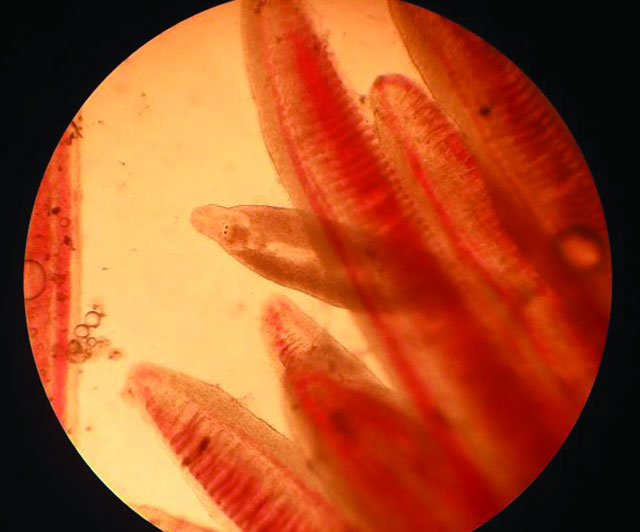In polluted water environment, Parasitic tapeworm will grow up and often develop into epidemics. The disease does not cause mass fish death but delays fish’s growth which affects productivity.
Ectoparasitic fluke disease
Agent
Caused by the two single fluke groups which are 16 hooks (Dactylogyrus) and 18 hooks fluke (Gyrodactylus), which have small body size ( 0.5 – 1 mm ). The disease appears mostly and causes serious harms to fingerlings. There is often high rate and intensity of the disease infection at the time of low temperature or high precipitation.
Symptoms
Normally, fluke parasitizes on fish skin, gills, causing ulcer or rot, creating good conditions for the development of other diseases. When there are few parasites, clinical symptoms can be vague. If they appear in a large number, fish’s gills will become inflamed, swollen and dark pink. The gill beams will be torn away and secrete much more viscousness which prevents the respiration by the fish and suffocates them. Infected with the disease, the fish often lose weight, swim lethargicly, float to water surface and concentrate mostly on the currents of water.

Prevention and treatment
Prevention
Feed the fish sufficiently with appropriate quality at each development stage. Do not rear the fish with too high density, regularly monitor the diet to adjust accordingly. Use diluted CaO lime to sprinkle in the water periodically in every 20 days, dosed at 1 – 2 kg/100 m3, Vicato HI – USA Para & Santa at 1 l/2,500 – 3,000 m3 of water in 15-day periods. Fish with slight tapeworm infection do not need treatment but merely changing water, dusting liming and suture management attention and care. Worms must be wiped out for the fish after 1.5 to 2 months at suitable dosages according to the producer’s instructions.
Treatment
When the fish get infected, net them up, wash with salt, dosed at 0.5 to 1 kg/100 liters of water, in 15 – 30 minutes. Bathe fish with praziquantel wih a concentration of 2.5 ppm in 24 – 32 hours. Use formaldehyde (7 – 10 ml/m3 water), spray throughout the pond in 10 – 11 hours.
(to be continued)